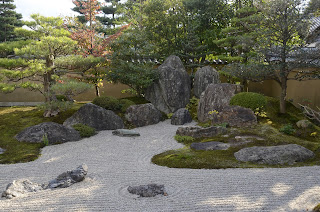 |
| Guo Xi (1020-1090) Early Spring |
The philosophical and aesthetic outlook of the Chinese
painters also came to shape the Japanese garden tradition in important ways.
For the painters the quality of ‘spirit’ was as vital as the ink they used. A
painting may be deemed technically correct, but it would critically ‘fail’
without an infusion of the mystery of ‘spirit’. Through their expression of
‘spirit’ the painters developed an aesthetic language that explored a way of
seeing landscape and the relationship of the viewer to that landscape. This way
of seeing points us to the heart of gardens too. So whether we are creating a
Japanese style garden or simply curious about their apparent simplicity and
grace, having some idea of the connections between Chinese landscape paintings
and the Japanese garden tradition can open new avenues of understanding and
appreciation.
 The Japanese garden tradition did not arise out of a vacuum,
there have been many influences that have come to contribute to what we can see
and understand as the Japanese garden today. The landscape of Japan itself, and
the aesthetic tastes and inclinations of Japanese society itself have been
important drivers in the development of the garden tradition over several hundreds of years. Of all those
influences one stands out in particular, Chinese landscape paintings. Japan
received an immense continental influence from China, nearly every aspect of
society was touched upon by this stream. Brought to Japan not only by Japanese
who travelled to China on political missions, but also by Chinese and Korean
religious figures and craftsmen who journeyed to Japan, some of who settled in
Japan for extended periods of time. It is possible that among these people
there were those with experience of creating gardens, though there does not
seem to be absolute documentary evidence to back up such a supposition.[1]
The Japanese garden tradition did not arise out of a vacuum,
there have been many influences that have come to contribute to what we can see
and understand as the Japanese garden today. The landscape of Japan itself, and
the aesthetic tastes and inclinations of Japanese society itself have been
important drivers in the development of the garden tradition over several hundreds of years. Of all those
influences one stands out in particular, Chinese landscape paintings. Japan
received an immense continental influence from China, nearly every aspect of
society was touched upon by this stream. Brought to Japan not only by Japanese
who travelled to China on political missions, but also by Chinese and Korean
religious figures and craftsmen who journeyed to Japan, some of who settled in
Japan for extended periods of time. It is possible that among these people
there were those with experience of creating gardens, though there does not
seem to be absolute documentary evidence to back up such a supposition.[1] |
| Ginkaku-ji |
 |
| Landscape painting by Sõami in Southern School style. |
In China landscape painting was regarded as the highest form
of art, superseding even that of portraiture. Paintings were created on paper
or silk and usually mounted as scrolls, they were painted with Indian ink in a
wide range of tones or washes. Both painting and the appreciation of paintings
were seen as cultural ambition, something that the elite in society engaged
with very seriously. Similarly, prowess in calligraphy was seen as a mark and a
measure of an educated person. In much of East Asia the natural landscape was
viewed as being the setting of the ultimate source of leadership and authority.
It was in landscape that humans sought to communicate directly with the deities
at sites thus designated as being sacred places. In China, it was in, and
through the landscape that emperors derived their political, moral and
spiritual authority by identification with the divine. There has been a
centuries old practice of retiring to remote regions in the landscape; this is
not exclusively an Asian practice, witness also the establishment of many early
Christian religious centres in remote and places difficult of access such as
Iona, Lindisfarne etc.
“In much of East Asian elite culture the landscape was
traditionally an image of spiritual freedom, religious power and moral
transcendence of the ambitions and avarice of ordinary life in the capital or
the various regional centres.” [2]
The creation of gardens was an extension of the notion of
sacred landscape, by creating ‘landscape gardens’ the intention was to provide
a place to attract the deities to, and to create a space in which people could
communicate with the deities. In time this idea became secularised, but that
does nothing to fundamentally undermine the link between gardens and the notion
of the sacred. Painting was another means of encapsulating the same desire for
identification with the divine, to participate in the transcendence of mundane
existence. To view a painting, as to view a garden, was to seek to participate
in the landscape being depicted, to internalise and identify with that
landscape, and in so doing break down any intellectual division between self
and object.
 |
| Hoshun-in, Kyoto |
Continued in Part 2.
[1] In ‘Themes, Scenes and Taste in the History of
Japanese Garden Art’ (1988), Wybe Kuitert rasies a hypothetical connection
between the Chinese Zen priest Lanqi Daolong (Jap. Rankei Dõryū) as a possible
source of direct continental influence particularly in connection with the
waterfall construction at Tenryū-ji.
[2] Joseph D. Parker, ‘Zen Buddhist Landscape Arts of
Early Muromachi Japan’. State University of New York. 1999
To follow this blog: the 'Follow by E-mail' facility is now operating. Don't miss a beat and sign in.
Also do not forget to try: http://www.newpages.com/blogs/writers-blogs.htm http://www.newpages.com/blogs/writers-blogs.htm


I think this is an informative post and it is very useful and knowledgeable. therefore, I would like to thank you for the efforts you have made in writing this article. Landscape Company in Montecito
ReplyDelete